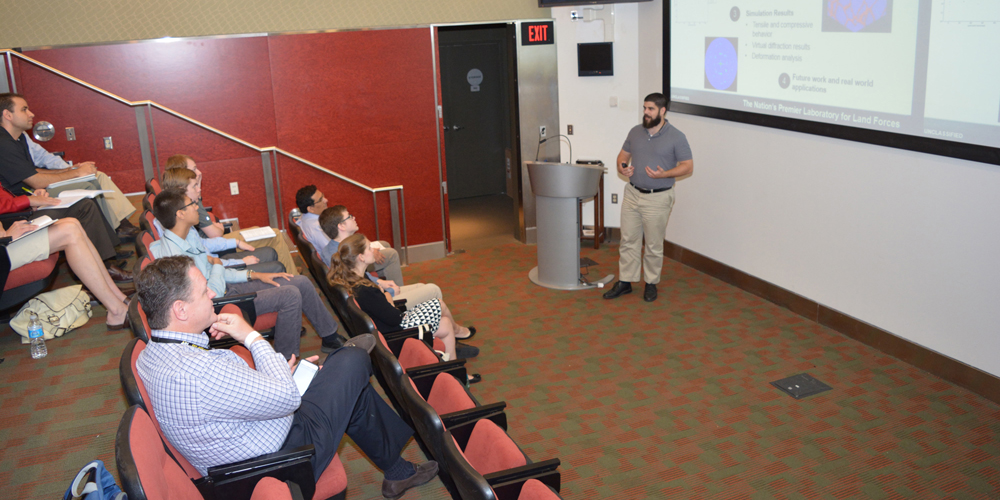
By David McNally, ARL Public Affairs
ABERDEEN PROVING GROUND, Md. — Six graduate students recently concluded the DOD High Performance Computing Internship Program, or HIP, at the U.S. Army Research Laboratory.
“The intern’s summer projects were highly relevant and critical to our mission,” said Dr. Luis Bravo, Vehicle Technology Directorate. “They really took the lead in creating complex models that push the boundaries of engine combustion and turbomachinery sciences and have exploited the use of DOD’s Supercomputing platforms.”
The annual HIP program funds interns to enhance computational skills and experience in order to support the DOD’s future warfighter needs.
“I used computer codes to look at the smallest scale of material that I could,” said Kathryn Esham, a graduate student from The Ohio State University. “I took the temperature from really high to really low to see what would happen to the material.”
Army scientists and engineers mentored the students throughout their projects. The highly technical research ranged from “High Fidelity Simulation of Engine Jet Combustion and Application to Turbomachinery” to “Tiltrotor Whirl Flutter Analysis with Computational Fluid Dynamics and Computational Structural Dynamics Coupling.”

Bradley Steele, a graduate student and summer intern with the DOD High Performance Computing Internship Program, presents the results of his research Aug. 3, 2016, before a panel of scientists, engineers and fellow students. (All photos by David McNally)
“The interns were able to work on research that is way beyond state-of-the-art,” said Dr. Anindya Ghoshal. “Basically we’re talking about technology that will come into use in actual engines maybe 20 to 30 years in the future.”
Ghoshal said the interns work on futuristic research was “highly relevant.”
“I’m very hopeful that this experience has been fruitful for them,” he said. “They were excited about the work that they did. They are also going to continue this work as part of their doctoral dissertations. It’s likely we will get them back in the future as interns again, so they can continue this work.”
Across the DOD, the Air Force won grants for 11 interns and the Navy and Army won 10 each. Of the Army interns, six worked at ARL facilities at APG.
The other interns were Richard Blocher, Christian Hoover, Bradley Steele, Matthew Guziewski and Daniel Foley. The group presented their research findings Aug. 3, 2016, before a panel of scientists, engineers and fellow students.

As the DOD High Performance Computing Internship Program concludes its 2016 session, graduate student Daniel Foley delivers the results of his summer project with the U.S. Army Research Laboratory.
Because of the “exemplary work” presented during the symposium, Bravo said, senior leadership invited three of the interns (Blocher, Esham and Wonnell) to publish a brief article in DOD’s HPC Insights magazine.
“In my view, it’s a recognition of the sophistication of the project and the immediate connection it has with the DOD community”, Bravo said. “For us, High Performance Computing is critical to our mission,” Bravo said. “It really enables us to do cutting edge research. It goes hand-in-hand with our experimental facilities.”
The internships develop the skills of future computational scientists and provide an opportunity for a prospective DOD employee to experience defense-related research and development, he said.
“My project had a large scope, and I didn’t know exactly what aspect I was going to be working on when I came here,” Blocher said. “The fact that it has a computational fluid dynamics focus, that’s a subject that’s new to me. It’s something that I learned a lot about that I didn’t really expect or know that I was going to learn about.”
“I think we’re going to continue looking for this type of support from the DOD’s High Performance Computing office,” Bravo said. “They were very happy with our interns’ output and we’re also very happy with the program support. We hope we can continue this kind of collaboration.”

Ohio State University graduate student Kathryn Esham delivers the results of her summer-long research with the Vehicle Technology Directorate at the U.S. Army Research Laboratory.
RELATED LINKS
U.S. Army Materiel Command
U.S. Army Research, Development and Engineering Command
ARL on Facebook
ARL on Twitter







